Apr 22, 2009
Revealed: Antarctic ice growing, not shrinking (Updated)
By Greg Roberts, The Australian
ICE is expanding in much of Antarctica, contrary to the widespread public belief that global warming is melting the continental ice cap. The results of ice-core drilling and sea ice monitoring indicate there is no large-scale melting of ice over most of Antarctica, although experts are concerned at ice losses on the continent’s western coast.
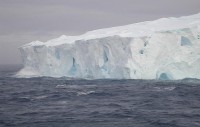
Antarctica has 90 per cent of the Earth’s ice and 80 per cent of its fresh water. Extensive melting of Antarctic ice sheets would be required to raise sea levels substantially, and ice is melting in parts of west Antarctica. The destabilisation of the Wilkins ice shelf generated international headlines this month. However, the picture is very different in east Antarctica, which includes the territory claimed by Australia.
East Antarctica is four times the size of west Antarctica and parts of it are cooling. The Scientific Committee on Antarctic Research report prepared for last week’s meeting of Antarctic Treaty nations in Washington noted the South Pole had shown “significant cooling in recent decades”.
Australian Antarctic Division glaciology program head Ian Allison said sea ice losses in west Antarctica over the past 30 years had been more than offset by increases in the Ross Sea region, just one sector of east Antarctica. “Sea ice conditions have remained stable in Antarctica generally,” Dr Allison said.
The melting of sea ice—fast ice and pack ice—does not cause sea levels to rise because the ice is in the water. Sea levels may rise with losses from freshwater ice sheets on the polar caps. In Antarctica, these losses are in the form of icebergs calved from ice shelves formed by glacial movements on the mainland.
Last week, federal Environment Minister Peter Garrett said experts predicted sea level rises of up to 6m from Antarctic melting by 2100, but the worst case scenario foreshadowed by the SCAR report was a 1.25m rise. Mr Garrett insisted global warming was causing ice losses throughout Antarctica. “I don’t think there’s any doubt it is contributing to what we’ve seen both on the Wilkins shelf and more generally in Antarctica,” he said.
Dr Allison said there was not any evidence of significant change in the mass of ice shelves in east Antarctica nor any indication that its ice cap was melting. “The only significant calvings in Antarctica have been in the west,” he said. And he cautioned that calvings of the magnitude seen recently in west Antarctica might not be unusual. “Ice shelves in general have episodic carvings and there can be large icebergs breaking off—I’m talking 100km or 200km long—every 10 or 20 or 50 years.” Ice core drilling in the fast ice off Australia’s Davis Station in East Antarctica by the Antarctic Climate and Ecosystems Co-Operative Research Centre shows that last year, the ice had a maximum thickness of 1.89m, its densest in 10 years. The average thickness of the ice at Davis since the 1950s is 1.67m.
A paper to be published soon by the British Antarctic Survey in the journal Geophysical Research Letters is expected to confirm that over the past 30 years, the area of sea ice around the continent has expanded. Read story here.
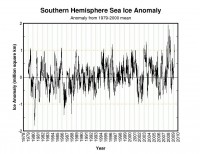
See full image from Cryosphere today here.
See also this story from the Australian where a Russian sea captain says “I see just more and more ice, not less ice.”
RUSSIAN sea captain Dimitri Zinchenko has been steering ships through the pack ice of Antarctica for three decades and is waiting to see evidence of the global warming about which he has heard so much. Zinchenko’s vessel, the Spirit of Enderby, was commissioned in January last year to retrace the steps of the great Antarctic explorer Ernest Shackleton, marking the century of his Nimrod expedition of 1907-09. Spirit of Enderby was blocked by a wall of pack ice at the entrance to the Ross Sea, about 400km short of Shackleton’s base hut at Cape Royds. Zinchenko says it was the first time in 15 years that vessels were unable to penetrate the Ross Sea in January. The experience was consistent with his impression that pack ice is expanding, not contracting, as would be expected in a rapidly warming world. “I see just more and more ice, not less ice.”
Rodney Russ, whose New Zealand company Heritage Expeditions has operated tourist expeditions to Antarctica for 20 years, agrees. He says ships regularly used to able to reach the US base of McMurdo in summer, but ice has prevented them from doing so for several years. “Vessels are usually stopped 8km to 14km short of the base. A few years ago, that was often open water,” Russ says. “We have experienced quite severe ice conditions over the past decade. I have seen nothing in this region to suggest global warming is having an effect.”
Finally see this detailed analysis that puts the Wilkins in perspective to the massive Antarctic ice sheet and this analysis by John McLean showing why the so called Wilkins collapse was another NSIDC, BAS and mainstream media con job.
UPDATE: Finally a New Scientists story “Why Antarctic ice is growing despite global warming ” by Catherine Brahic reports CFCs and other ozone-depleting chemicals have given the South Pole respite from global warming. But only temporarily. According to John Turner of the British Antarctic Survey, the effect will last roughly another decade before Antarctic sea ice starts to decline as well. (ICECAP translation: 10 more years of funding ought to get me nicely to retirement) “By the end of the century we expect one third of Antarctic sea ice to disappear,” says Turner. (H/T Marc Morano, ClimateDepot.com)
Apr 21, 2009
Use Energy, Get Rich and Save the Planet
By John Tierney, the New York Times
When the first Earth Day took place in 1970, American environmentalists had good reason to feel guilty. The nation’s affluence and advanced technology seemed so obviously bad for the planet that they were featured in a famous equation developed by the ecologist Paul Ehrlich and the physicist John P. Holdren, who is now President Obama’s science adviser.
Their equation was I=PAT, which means that environmental impact is equal to population multiplied by affluence multiplied by technology. Protecting the planet seemed to require fewer people, less wealth and simpler technology - the same sort of social transformation and energy revolution that will be advocated at many Earth Day rallies on Wednesday.
But among researchers who analyze environmental data, a lot has changed since the 1970s. With the benefit of their hindsight and improved equations, I’ll make a couple of predictions:
1. There will be no green revolution in energy or anything else. No leader or law or treaty will radically change the energy sources for people and industries in the United States or other countries. No recession or depression will make a lasting change in consumers’ passions to use energy, make money and buy new technology - and that, believe it or not, is good news, because…
2. The richer everyone gets, the greener the planet will be in the long run.
I realize this second prediction seems hard to believe when you consider the carbon being dumped into the atmosphere today by Americans, and the projections for increasing emissions from India and China as they get richer.
Those projections make it easy to assume that affluence and technology inflict more harm on the environment. But while pollution can increase when a country starts industrializing, as people get wealthier they can afford cleaner water and air. They start using sources of energy that are less carbon-intensive - and not just because they’re worried about global warming. The process of “decarbonization” started long before Al Gore was born.
The old wealth-is-bad IPAT theory may have made intuitive sense, but it didn’t jibe with the data that has been analyzed since that first Earth Day. By the 1990s, researchers realized that graphs of environmental impact didn’t produce a simple upward-sloping line as countries got richer. The line more often rose, flattened out and then reversed so that it sloped downward, forming the shape of a dome or an inverted U - what’s called a Kuznets curve. (See nytimes.com/tierneylab for an example.)
In dozens of studies, researchers identified Kuznets curves for a variety of environmental problems. There are exceptions to the trend, especially in countries with inept governments and poor systems of property rights, but in general, richer is eventually greener. As incomes go up, people often focus first on cleaning up their drinking water, and then later on air pollutants like sulfur dioxide. As their wealth grows, people consume more energy, but they move to more efficient and cleaner sources - from wood to coal and oil, and then to natural gas and nuclear power, progressively emitting less carbon per unit of energy.
“Once you have lots of high-rises filled with computers operating all the time, the energy delivered has to be very clean and compact,” said Mr. Ausubel, the director of the Program for the Human Environment at Rockefeller. “The long-term trend is toward natural gas and nuclear power, or conceivably solar power. If the energy system is left to its own devices, most of the carbon will be out of it by 2060 or 2070.”
Read more here.
Apr 17, 2009
SPPI Monthly CO2 Report
Edited by Christopher Monckton on SPPI
SPPI’s authoritative Monthly CO2 Report for March 2009 demonstrates that all global-temperature datasets show rapid global cooling for seven full years, at a rate equivalent to 2 C (3.6 F) per century.
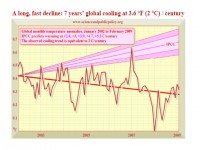
See larger image here.
Other main points:
Since Al Gore’s climate movie An Inconvenient Truth was launched in January 2005, global cooling has occurred at the equivalent of 10 F (5.5 C) per century. If this rapid cooling were to continue, the Earth would be in an Ice Age by 2100.
The UN’s climate panel, the IPCC, had projected temperature increases at 4.5 to 9.5 F (2.4 to 5.3 C) per century, with a central estimate of 7 F (3.9 C) per century. None of the IPCC’s computer models had predicted a prolonged cooling.
The IPCC’s estimates of growth in atmospheric CO2 concentration are excessive. They assume CO2 concentration will rise exponentially from today’s 385 parts per million to reach 730 to 1020 ppm, central estimate 836 ppm, by 2100.
However, for seven years, CO2 concentration has been rising in a straight line towards just 575 ppmv by 2100. This alone halves the IPCC’s temperature projections. Since 1980 temperature has risen at only 2.5 F (1.5 C) per century.
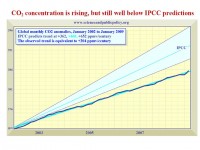
See larger image here.
Sea level rose just 8 inches in the 20th century and has been rising at just 1 ft/century since 1993. Though James Hansen of NASA says sea level will rise 246 feet, sea level has scarcely risen since the beginning of 2006.
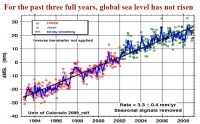
See larger image here.
Sea ice extent in the Arctic has now recovered to the 30-year average. In the Antarctic, sea ice extent reached a record high late in 2007, and has remained plentiful since. Global sea ice extent shows little trend for 30 years.
The Accumulated Cyclone Energy Index is a 24-month running sum of monthly energy levels in all hurricanes, typhoons and tropical cyclones. The Index shows that at present there is less severe tropical-storm activity than at any time in 30 years.
Satellite measurements prove that official predictions overestimate CO2’s effect on temperature 15-fold.
Proof that CO2’s warming effect is exaggerated
LAST MONTH Science Focus calculated that the UN had approximately (and perhaps inadvertently) doubled the value of each of four parameters, and had then multiplied them together, causing a 15-fold exaggeration of the anthropogenic increase in global surface temperature. This month, with grateful acknowledgement to Professor Richard Lindzen, we provide real-world confirmation of our theoretically-calculated conclusion.
In addition to any long-term trends, temperature fluctuates on shorter time scales - years to decades. These natural variations are associated with the internal dynamics of the ocean-atmosphere system. Examples include the El Nino Southern Oscillation and the Pacific Decadal Oscillation. These fluctuations must excite the feedback mechanisms that we have just described. When they lead to warmer temperatures, heat radiation escaping from Earth to space should increase, but positive feedbacks should inhibit the outgoing radiation by virtue of the enhanced ‘blanketing’, which, if the UN’s models are right, should typically reduce the escaping heat radiation by a factor of about 3 compared with what one would see in the absence of feedbacks.

See larger image here. Observed (green) long-wave flux anomalies for the tropics against the mean of five climate model simulations (black) using observed sea surface temperature, and the total range of model-predicted anomalies (gray band). Source: Wielicki, B.A., T. Wong et al. 2002. Evidence for large decadal variability in the tropical mean radiative energy budget. Science 295: 841-844.
Satellite measurement: We can measure the escaping heat radiation using satellites. If the satellite data were to confirm the predictions made by the computer models on which the UN relies, we should have solid evidence that the modeled feedbacks were correct. However, it turns out that the satellite data do not confirm the UN’s predictions.
Read full detailed reports and see more images and also some new paper reviews here.
Apr 17, 2009
‘We ♥ CO2’: Reform Party of BC
Garrett Zehr, the Tyee
The debate over the carbon tax is proving that politics really does make for strange bedfellows. Joining the British Columbia New Democratic Party in vowing to axe the tax is the Reform Party of B.C., who have adopted the slogan, “We ♥ CO2.”
“We will repudiate the tax - it’s a scam,’ said Reform leader David Hawkins. The party would also set out to prove that the accepted carbon-driven model for explaining climate change is “scientific fraud.” Also lining up behind the NDP in railing against the carbon tax are the B.C. Conservatives, who have made the issue one of the six main planks of their platform.
Not only would they give the taxation of carbon the boot, the party also proposes getting rid of B.C.’s property transfer tax and lowering personal and corporate taxes.
Those supporting the carbon tax are also parties that often don’t see eye to eye. The tax, brought in by the B.C. Liberal Party, has received much support from the Green Party of B.C. “I do want to commend the B.C. Liberals for introducing the carbon tax and tax shifting,” said party leader Jane Sterk last fall. The Greens want a carbon tax in combination with a cap and trade climate policy and also propose higher taxes on polluting industries. See story here.
Good luck to the Reform Party. Bring sanity to Canadian politics and give ‘agita’ to B.C. IPCC alarmist modeler Andrew Weaver and the phonies at desmogblog. Kudos to Hans Schreuder who has a blog site I Love My CO2 that has been vindicating this harmless gas. CO2 is actually a highly beneficial gas that acts as a plant fertilizer which has helped according to NASA to increase crop yields in the Northern Hemisphere by 30% with just 10% more land over the last 50 years, feeding millions more of the world’s people.
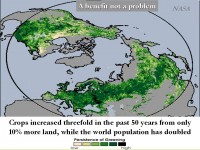
See larger image here.
Apr 14, 2009
Peter Foster: An Inconvenient Film
By Peter Foster, The National Post
Gore is about to feature in a new movie, but he’s not going to like it very much. Titled Not Evil Just Wrong: The True Cost of Global Warming Hysteria, the film presents a devastating account of the shaky foundations and hefty price of Mr. Gore’s brand of self-interested and hypocritical alarmism. Created by the Irish film making duo of Phelim McAleer and Ann McElhinney -who made another excellent documentary about the “dark side of environmentalism” called Mine Your Own Business - Not Evil provides the perfect rebuttal to Mr. Gore’s An Inconvenient Truth.
Despite being chock-a-block with inaccuracies and misrepresentations, Mr. Gore’s movie has frightened schoolchildren all over the world, driven the public policy debate, and garnered both an Academy Award and a Nobel Peace Prize for its star. Not Evil - which is due to be released later this year - will appear at a crucial time. The world’s crisis-beset nations are due to meet in Copenhagen in November to concoct a new policy straitjacket to succeed the meddlesome but utterly failed Kyoto Accord. If global warming’s U.N.-based ringmasters have their way, this will lead to a slashing of industrial production in developed countries and to a huge extension of boondoggle redistributionist schemes to fund “green” technologies in developing countries.
Alternating credible skeptics with arresting imagery, the film makes clear that the science, far from being settled, has been comprehensively misrepresented by the likes of NASA’s James Hansen, who is to Al Gore and climatology what Trofim Lysenko was to Joseph Stalin and agronomy.
There is a wonderful scene of Mr. Hansen becoming almost discombobulated at the very mention of Stephen McIntyre, the maverick Canadian who, with the help of Guelph economist Ross McKitrick, took on the UN climate change establishment over the so-called “hockey stick” temperature graph, and won. Mr. Hansen claims that paying attention to such inconvenient truths amounts to just “clouding the issue”
The film dramatically outlines the dreadful damage already done by environmental hysteria, in particular the millions of unnecessary deaths caused by the campaign against DDT. That campaign started with Rachel Carson’s Silent Spring, which was at the root of the modern environmental movement in every sense. Despite the World Health Organization’s lifting of the DDT ban, Al Gore remains devoted to Ms. Carson’s memory. And methods. As Patrick Moore, one of the founders of Greenpeace but now a skeptic, points out, radical environmentalists “care more about fish eggs than they do about children.” Meanwhile kids are shown fretting about about imminent global inundation and the deaths of polar bears.
Just as Mine Your Own Business showed how opposition to mining in developing countries comes often not from the “grassroots” but from well-funded multinational NGOs with as little concern for local employment as they have for truth, so Not Evil Just Wrong further demonstrates environmentalists’ disregard for humanity, and in particular the poor.
Perhaps the most memorable scene in Mine Your Own Business was that of the WWF’s local representative in Madagascar, Mark Fenn, who was leading opposition to a development by Rio Tinto. The appalling Mr. Fenn, who owned a $35,000 catamaran and was building a local luxury home, claimed that poor people were happier, and that if the locals had more money they would “just spend it.” The film makers have come up with similar buffoons for their new movie, including a Bible-thumping environmentalist in Uganda who opposes using DDT and claims that the U.S. never experienced malaria and Hollywood actor Ed Begley, who suggests that Fijians are “happy with nothing.”
Not Evil Just Wrong which will be released later this year - is an important film that deserves the widest possible distribution, both in theatres and schools. The only quibble that I have with it is that its title might be too generous to those it exposes. To find out more about the movie and the fundraising campaign to help its distribution visit its website.
|









